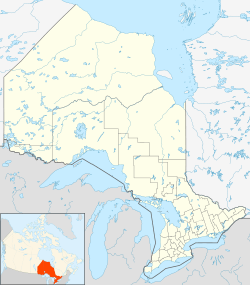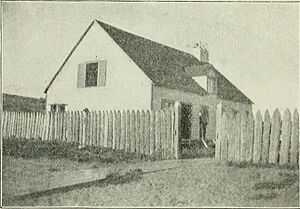Mishkeegogamang First Nation facts for kids
Quick facts for kids
Mishkeegogamang Ojibway Nation
|
||
|---|---|---|
|
First Nation
|
||
| Mishkeegogamang First Nation | ||
|
||
| Country | Canada | |
| Province | Ontario | |
| Provincial Territorial Organization | Nishnawbe Aski Nation | |
| District | Kenora | |
| Area | ||
| • Total | 18,696.4 ha (46,199.8 acre) | |
| Population | ||
| • Total | 2,100+ Registered Band Members | |
| Postal Code |
P0V 2H0
|
|
| Area code(s) | 807 | |
| Website | www.mishkeegogamang.ca | |
The Mishkeegogamang First Nation is an Ojibway community in Ontario, Canada. It's a self-governing group of First Nation people. Before 1993, this community was known as the Osnaburgh First Nation. You might have heard of places like New Osnaburgh or Osnaburgh House, which were also part of this group.
The Mishkeegogamang Ojibway people have a large traditional territory. This land stretches far beyond their main reserve areas. It includes many smaller communities like Bottle Hill, Poplar Heights, Sandy Road, and Doghole Bay. It also covers areas around Lake St. Joseph.
The main language spoken by the Mishkeegogamang people is Ojibwe (Anishinaabemowin), written as ᐊᓂᔑᓈᐯᒧᐎᓐ.
The community is located along Highway 599 in the Kenora District. It's about 20 kilometres (12 miles) south of Pickle Lake. In March 2022, there were over 2,000 registered members. More than 1,000 of them lived on the reserve. The Mishkeegogamang First Nation is part of the Nishnawbe Aski Nation, a larger organization that supports many First Nations.
Contents
Where Mishkeegogamang Lives
The Mishkeegogamang First Nation has two main land areas, called reserves. The smaller one is called Osnaburgh Indian Reserve 63A, and the larger one is Osnaburgh Indian Reserve 63B.
Their Land and Communities
- Osnaburgh 63A is located in the Thunder Bay District.
- Osnaburgh 63B is in the Kenora District.
- The Mishkeegogamang community does not follow daylight saving time.
- The First Nation is made up of several smaller communities that are spread out. On their main reserve, you'll find Bottle Hill, Poplar Heights, and Sandy Road.
- Other communities linked to the First Nation include Ten Houses (about 24 km or 15 miles south), Doghole Bay, Eric Lake, and Ace Lake.
Getting Around and Staying Connected
Life in Mishkeegogamang involves different ways of travel and modern services.
How They Travel
- The Mishkeegogamang First Nation can be reached by road all year long. It's right on Highway 599, about 20 km (12 miles) south of Pickle Lake.
- For longer trips, people use the nearby Pickle Lake Airport. This airport offers flights for both passengers and cargo.
Staying Healthy
- The Mishkeegogamang Health Centre is on Highway 599, within the main reserve. It works as a nursing station and manages health programs.
- Nurses, Community Health Representatives, and visiting doctors provide healthcare services.
- The Health Centre is part of a program that connects patients with critical care doctors in Thunder Bay using video calls. This helps people get expert advice before they might need to be flown to a hospital by air ambulance (Ornge).
- If someone needs a major hospital, they can go to places like Sioux Lookout Meno Ya Win Health Centre or Thunder Bay Regional Health Sciences Centre. Some might also go to hospitals in Winnipeg, like the Health Sciences Centre or The Children's Hospital of Winnipeg.
Daily Life and Services
- The Mishkeegogamang First Nation provides important services like Water, sewage, garbage collection, and snow removal.
- They also hire private companies for things like electrical, plumbing, and propane services.
- The community gets its electricity from the main power grid through the Wataynikaneyap Power line.
- For phones, cell service, TV, and internet, Bell Canada is the main provider. However, residents can also choose other companies like Starlink or Xplornet.
Their Leaders
The Mishkeegogamang First Nation is led by a Chief and five Band Councillors. They are elected every two years.
Chief and Council (2023-2025)
| Role | First Name | Last Name | Start Date | End Date |
|---|---|---|---|---|
| Chief | MERLE | LOON | 08/10/2023 | 08/09/2025 |
| Head Councillor | TANYA | BOTTLE | 08/10/2023 | 08/09/2025 |
| Councillor | MAXINE | SKUNK | 08/10/2023 | 08/09/2025 |
| Councillor | BRENDA | FOX | 08/10/2023 | 08/09/2025 |
| Councillor | LINDA | KAMINAWAISH | 08/10/2023 | 08/09/2025 |
| Councillor | MARY ANN | PANACHEESE-SKUNK | 08/10/2023 | 08/09/2025 |
- The community's police services are provided by the Nishnawbe-Aski Police Service. This is a police force for Indigenous communities. They can also work with the Ontario Provincial Police in nearby Pickle Lake.
- When it's time to vote, Mishkeegogamang residents vote in the Kenora area for federal elections. For provincial elections, they vote in the Kiiwetinoong area. Kiiwetinoong means "North" in Ojibwe and has a large Indigenous population.
A Look Back in Time
The history of the Mishkeegogamang people is rich and goes back many years.
Early Days
- The Mishkeegogamang people are Ojibway. It's believed they originally came from the Great Lakes region.
- They might have moved north when European traders from the Hudson's Bay Company started setting up trading posts. This move pushed the Cree people who lived there before them further north.
The Trading Post
- The Hudson's Bay Company wanted to build trading posts deeper inland. So, they sent John Best to find a good spot. He chose a place near Lake St. Joseph and named the post Osnaburgh House.
- This trading post lasted for about 200 years. Later, a settlement called Osnaburgh grew directly across the lake from the house.
- The trading post was closed in 1963 and eventually fell into ruins. Today, the site is a fishing camp called Old Post Lodge.
Modern Times
- In 1905, the Canadian government made Treaty 9 with the Mishkeegogamang and other groups. This treaty set aside two areas of land for reserves (Osnaburgh 63A and 63B). It also promised that the people could still use all their traditional lands.
- At this time, the community became more formally organized. Missabay was chosen as the first chief, and a system with a band and council was started.
- When Highway 599 was finished in 1954, it brought big changes. The highway was a few kilometres from the old Osnaburgh village. So, the government encouraged people to move to a new village called New Osnaburgh. This new village, on Doghole Lake, is now the Main Reserve.
- Mishkeegogamang still has strong connections with other First Nations, like Cat Lake First Nation, Slate Falls First Nation, and the Ojibway Nation of Saugeen.
Chiefs Since 1905
| Chief | Elected Year | Expiry Year | Notes |
|---|---|---|---|
| Daniel Missabay | Prior to 1905 | ||
| The Osnaburgh Band of Ojibways signed The James Bay Treaty (Treaty No. 9) | |||
| Daniel Missabay | 1905 | 1908 | Died in 1908 |
| George Wawaashkung | 1908 | 1914 | First time as Chief |
| Keewaykeesicquayosh | 1914 | 1915 | First time as Chief |
| George Wawaashkung | 1915 | 1916 | Second time as Chief |
| Johh Skunk | 1916 | 1923 | First time as Chief |
| Peter Moquano | 1923 | 1926 | First time as Chief |
| James Ruben | 1926 | 1929 | First time as Chief |
| John Carpenter | 1929 | 1935 | First time as Chief |
| Peter Moquano | 1935 | 1938 | Second time; resigned |
| William Semia Oombash | 1938 | 1941 | First time as Chief |
| James Masakeyash | 1941 | 1965 | First time as Chief |
| Levius Wesley | 1965 | 1967 | First time as Chief |
| James Masakeyash | 1967 | 1969 | Second time as Chief |
| Sam Skunk | 1969 | 1971 | First time; resigned |
| Robert Lastheels | 1971 | 1975 | First time as Chief |
| Daniel Panacheese | 1975 | 1977 | First time as Chief |
| Maurice Loon | 1977 | 1978 | First time; resigned |
| Aloysuis Kaminaiwash | 1978 | 1981 | First time as Chief |
| Roy Kaminaiwash | 1981 | 1983 | First time as Chief |
| Maurice Loon | 1983 | 1985 | Second time as Chief |
| Roy Kaminaiwash | 1985 | 1993 | Second time as Chief |
| The "Osnaburgh Band" name changed to "Mishkeegogamang" | |||
| Ronald Roundhead | 1993 | 2005 | First time as Chief |
| Connie Gray Mckay | 2005 | 2017 | First time as Chief |
| David Masakeyash | 2017 | 2023 | First time as Chief |
| Merle Loon | 2023 | * | First time as Chief |
Images for kids






